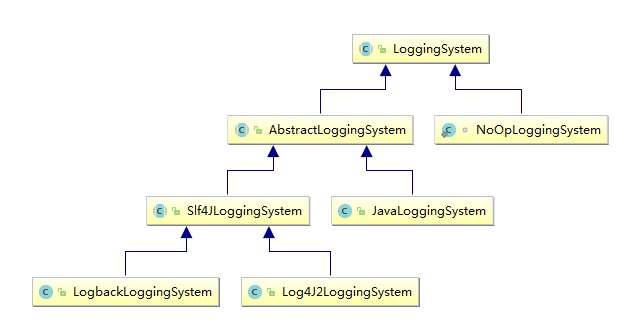Spring Boot默认使用slf4j+logback,下面通过源码一探究竟!
SpringBoot对日志的配置和加载进行了封装,让我们可以很方便地使用一些日志框架,只需要定义对应日志框架的配置文件,比如LogBack、Log4j、Log4j2等,代码内部便可以直接使用。
SpringBoot对日志功能的封装继承图:

LoggingSystem内部结构
从图中也可以发现目前SpringBoot支持4种类型的日志:
- JDK内置的Log(JavaLoggingSystem)
- Log4j(Log4JLoggingSystem)
- Log4j2(Log4J2LoggingSystem)
- Logback(LogbackLoggingSystem)
LoggingSystem是个抽象类,内部有这几个方法:
- beforeInitialize方法:日志系统初始化之前需要处理的事情。抽象方法,不同的日志架构进行不同的处理
- initialize方法:初始化日志系统。默认不进行任何处理,需子类进行初始化工作
- cleanUp方法:日志系统的清除工作。默认不进行任何处理,需子类进行清除工作
- getShutdownHandler方法:返回一个Runnable用于当jvm退出的时候处理日志系统关闭后需要进行的操作,默认返回null,也就是什么都不做
- setLogLevel方法:抽象方法,用于设置对应logger的级别
LoggingSystem的初始化
LoggingApplicationListener是ApplicationListener接口的实现类,会被springboot使用工厂加载机制加载。
1
2
3
4
5
6
7
8
9
10
11
12
13
14
15
16
17
18
19
20
21
22
23
24
25
26
27
28
29
30
31
32
33
34
35
36
37
38
39
40
41
42
43
44
45
46
47
48
49
50
51
52
53
54
55
56
57
58
59
60
61
62
63
64
65
66
67
68
69
70
71
72
73
74
75
76
77
| // LoggingApplicationListener.class
@Override
public void onApplicationEvent(ApplicationEvent event) {
// SpringApplication的run方法执行的时候触发该事件
if (event instanceof ApplicationStartedEvent) {
// onApplicationStartedEvent方法内部会先得到LoggingSystem,然后调用beforeInitialize方法
onApplicationStartedEvent((ApplicationStartedEvent) event);
}
// 环境信息准备好,ApplicationContext创建之前触发该事件
else if (event instanceof ApplicationEnvironmentPreparedEvent) {
// onApplicationEnvironmentPreparedEvent方法内部会做一下几个事情
// 1. 读取配置文件中"logging."开头的配置,比如logging.pattern.level, logging.pattern.console等设置到系统属性中
// 2. 构造一个LogFile(LogFile是对日志对外输出文件的封装),使用LogFile的静态方法get构造,会使用配置文件中logging.file和logging.path配置构造
// 3. 判断配置中是否配置了debug并为true,如果是,设置level的DEBUG,然后继续查看是否配置了trace并为true,如果是,设置level的TRACE
// 4. 构造LoggingInitializationContext,查看是否配置了logging.config,如有配置,调用LoggingSystem的initialize方法并带上该参数,否则调用initialize方法并且configLocation为null
// 5. 设置一些比如org.springframework.boot、org.springframework、org.apache.tomcat、org.apache.catalina、org.eclipse.jetty、org.hibernate.tool.hbm2ddl、org.hibernate.SQL这些包的log level,跟第3步的level一样
// 6. 查看是否配置了logging.register-shutdown-hook,如配置并设置为true,使用addShutdownHook的addShutdownHook方法加入LoggingSystem的getShutdownHandler
onApplicationEnvironmentPreparedEvent(
(ApplicationEnvironmentPreparedEvent) event);
}
// Spring容器创建好,并进行了部分操作之后触发该事件
else if (event instanceof ApplicationPreparedEvent) {
// onApplicationPreparedEvent方法内部会把LoggingSystem注册到BeanFactory中(前期是BeanFactory中不存在name为springBootLoggingSystem的实例)
onApplicationPreparedEvent((ApplicationPreparedEvent) event);
}
// Spring容器关闭的时候触发该事件
else if (event instanceof ContextClosedEvent && ((ContextClosedEvent) event)
.getApplicationContext().getParent() == null) {
// onContextClosedEvent方法内部调用LoggingSystem的cleanUp方法进行清除工作
onContextClosedEvent();
}
}
private void onApplicationStartedEvent(ApplicationStartedEvent event) {
// 一开始先使用LoggingSystem的静态方法get获取LoggingSystem
// 静态方法get会从下面那段static代码块中得到的Map中进行遍历
// 如果对应的key(key是某个类的全名)在classloader中存在,那么会构造该key对应的value对应的LoggingSystem
this.loggingSystem = LoggingSystem
.get(event.getSpringApplication().getClassLoader());
this.loggingSystem.beforeInitialize();
}
static {
Map<String, String> systems = new LinkedHashMap<String, String>();
systems.put("ch.qos.logback.core.Appender",
"org.springframework.boot.logging.logback.LogbackLoggingSystem");
systems.put("org.apache.logging.log4j.core.impl.Log4jContextFactory",
"org.springframework.boot.logging.log4j2.Log4J2LoggingSystem");
systems.put("org.apache.log4j.PropertyConfigurator",
"org.springframework.boot.logging.log4j.Log4JLoggingSystem");
systems.put("java.util.logging.LogManager",
"org.springframework.boot.logging.java.JavaLoggingSystem");
SYSTEMS = Collections.unmodifiableMap(systems);
}
private void onApplicationEnvironmentPreparedEvent(
ApplicationEnvironmentPreparedEvent event) {
if (this.loggingSystem == null) {
this.loggingSystem = LoggingSystem
.get(event.getSpringApplication().getClassLoader());
}
initialize(event.getEnvironment(), event.getSpringApplication().getClassLoader());
}
private void onApplicationPreparedEvent(ApplicationPreparedEvent event) {
ConfigurableListableBeanFactory beanFactory = event.getApplicationContext()
.getBeanFactory();
if (!beanFactory.containsBean(LOGGING_SYSTEM_BEAN_NAME)) {
beanFactory.registerSingleton(LOGGING_SYSTEM_BEAN_NAME, this.loggingSystem);
}
}
private void onContextClosedEvent() {
if (this.loggingSystem != null) {
this.loggingSystem.cleanUp();
}
}
|
spring-boot-starter模块内部会引用spring-boot-starter-logging模块,这个starter-logging模块内部会引入logback相关的依赖。这一依赖会导致LoggingSystem的静态方法get获取LoggingSystem的时候会得到LogbackLoggingSystem。
因此默认情况下,springboot程序基本都是使用logback作为默认的日志。
